21 Clever Uses for White Vinegar in The Frugal Home
This website may earn commissions from purchases made through links in this post.
There are many uses for white vinegar in the home, making it an invaluable addition to any pantry. Replace chemicals with vinegar for a more natural, eco-friendly (and frugal!) home.
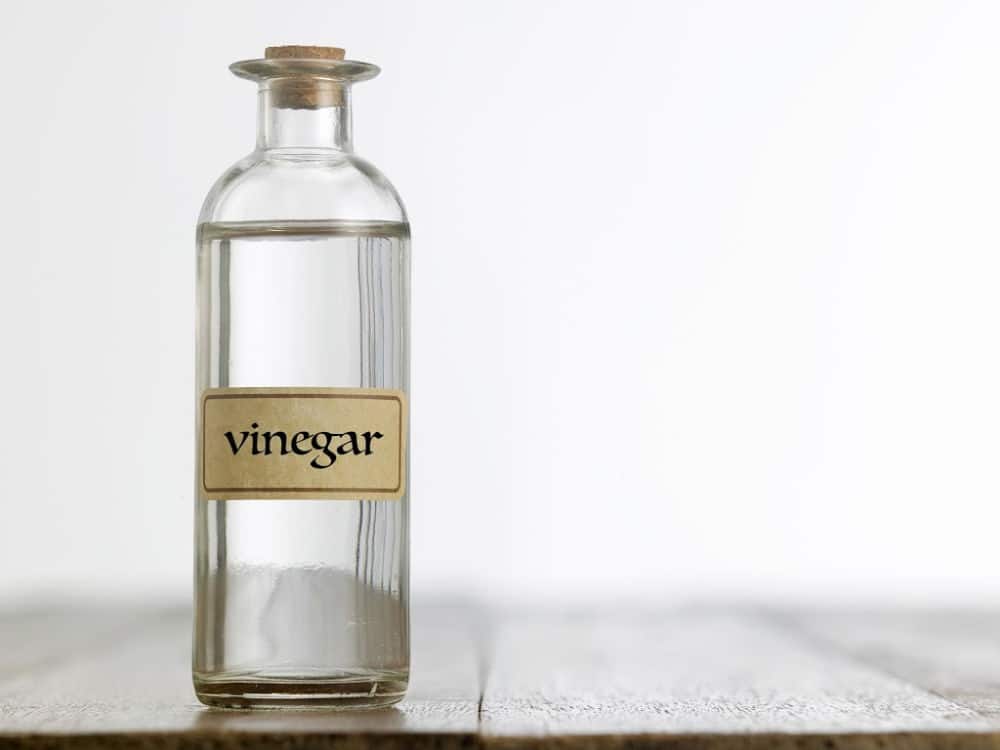
If there were only two natural products you could choose to stock in your home, it would have to be vinegar and bicarbonate of soda. These two inexpensive pantry staples can fix many problems within the home.
While there are many different kinds of vinegar for cooking with, this article covers the humble cheap white vinegar. Plain white vinegar is definitely the workhorse of the vinegar family.
Cleaning with white vinegar means you’re avoiding harsh chemicals in your home. It is environmentally friendly, economical and effective in killing mould and most bacteria.
Why buy dozens of products when one inexpensive one does the job?
Some Important Tips for Using Vinegar Safely
While vinegar is both natural and edible, it’s important to keep a few things in mind when using it around the home.
The first is that it should NEVER be mixed with bleach. Mixing the two will release toxic chlorine gas, which is harmful. So avoid using vinegar with bleach or products that have bleach in them together.
The other product to avoid mixing with vinegar is hydrogen peroxide. This can create peracetic acid, which is corrosive and can harm your skin, eyes, nose and throat.
There are also things that are best NOT cleaned with vinegar. Avoid cleaning natural stone, granite and marble benchtops, floors or tiles with vinegar as it may cause pitting.
Also, avoid cleaning wooden furniture or hardwood floors with vinegar. Vinegar is an acid, and it may strip wooden furniture of it’s finish. It may also damage frosted glass.
With those precautions in mind, here are # uses for white vinegar around the home.
Uses for White Vinegar in the Home
There are dozens of uses for white vinegar around the home besides using it as a condiment (like white vinegar on hot chips – yum!). Here are some of the ways you can use it.
1. Pickle Excess Veggies
Pickling vegetables is a great way to preserve them – and pickles taste great too! To pickle vegetables, you need vegetables, salt, sugar, optional flavourings like garlic and dill and of course white vinegar!
To get started, check out this article explaining how to make easy pickled vegetables on A Couple of Cooks blog.
2. Use Vinegar as a Cleaner
Vinegar makes a great cleaner (keeping in mind the precautions above).
Mildly acidic and mildly anti-bacterial, vinegar not only cuts through grease, but it also disinfects.
Here is the recipe for the all-purpose cleaner that I have been using for over a decade now. It uses vinegar, a little eco-dish detergent and some tea tree oil. Our builder recommended vinegar to clean our new shower – not commercial cleaners – for a better clean.
Vinegar is also an ingredient in my favourite floor cleaner.
3. Clean Your Windows with Vinegar
Equal parts of vinegar and warm water make an effective, natural and inexpensive window cleaner.
If your windows are covered in greasy little handmarks like mine, adding a little dishwashing detergent to the mix can boost the vinegar and water solution.
4. Use Vinegar for a Waterway-Friendly Toilet Cleaner
Straight vinegar is effective for cleaning the toilet.
You can read more about our natural toilet cleaning routine here.
5. Use Vinegar to Clean Smelly Drains
Clean the drains by pouring 1/2 – 1 cup of bicarbonate of soda down the drain, followed by 1 cup of white vinegar.
Leave for 10 minutes to bubble then pour 1 kettle full of boiling water down the drain.
6. Clean the Oven Door
Spray a small amount of vinegar on the oven door. Leave for 10 minutes before wiping off.
For stubborn stains, rub a little bicarbonate of soda mixed with a tiny bit of water to make a paste. Then clean with a mixture of vinegar, dish detergent and warm water (yep, that’s the same as the window cleaner!).
Some people have success cleaning their whole oven this way. But I have to admit, although I’ve tried several times, I haven’t had any luck cleaning the whole oven with just vinegar and bicarb soda. I’m guessing that vinegar will work if you clean the oven more regularly than once a year.
7. Remove Smells from Plastic Containers
Do you have plastic containers that smell strongly of onion or curry or something else that was stored in them?
Add a dash of vinegar to smelly plastic containers and top up with water.
Leave to soak overnight and then wash as usual to remove the smell.
8. Clean Mould with Vinegar
Vinegar is an effective way to kill mould, killing up to 82% of mould species. Unlike bleach, vinegar can penetrate surfaces, killing mould roots. It works by causing mould to overeat and die.
To clean mould, spray mould with plenty of vinegar at a dilution of 80% vinegar to 20% water. Leave for an hour to sit and absorb the vinegar. Scrub with a brush and then rinse well.
While vinegar does kill mould, it doesn’t get rid of discolouration. To remove the discolouration, scrub with a paste made from bicarbonate of soda and water.
Mould needs organic material to grow on, so clean regularly to prevent mould growth.
9. Use Vinegar
Add 1/4 cup of vinegar to the rinse cycle of towels to help soften and deodorise them.
I tend to just pour a little into the fabric softener holder in the washing machine, adding a little eucalyptus oil as well for freshness.
Be aware that some washing machine manufacturers recommend not using vinegar because the acid can wear rubber seals and hoses. It depends on what the seals are made from.
10. Whiten Whites with Vinegar
Adding one cup of vinegar to the rinse cycle of your colours wash will help keep colours bright or a cup added to your whites load will help whiten whites.
11. Clean Nappies With Vinegar
Soak nappies in a nappy bucket with a splash of vinegar to help sanitise. Vinegar can also help neutralise PH and help prevent nappy rash.
12. Soak Dishcloths, Tea Towels in Vinegar
Reusable dishcloths reduce waste. But sometimes they can go a bit funky smelling.
Soak them in a bucket of water with a 1/2 cup of vinegar to get rid of the funky smell.
This works also for tea towels, flannels, hand towels bibs etc.
13. Use Vinegar to Clean Up Pet Wee
Vinegar helps neutralise the ammonia in pet urine, which also helps neutralise the smell.
To clean pet wee, first, blot with an old towel.
Next, spray the carpet in a 50/50 solution of vinegar and water. Soak the area, but not enough to soak through to the underlay.
Give the area a scrub, getting into all the fibre, then cover with bicarbonate of soda. Leave to dry (this might take a couple of days) and then vacuum up.
14. Clean Carpet Stains with Vinegar
To clean carpet stains, remove any debris and blot excess liquid. Spray with a solution of vinegar, water and a little dish detergent and leave for 10 minutes.
(Tip: test for colourfastness first in an inconspicuous spot.)
Next, blot the stain away with an old towel, working from the outside in to avoid spreading the stain.
15. Stop Insect Bites from Itching
Dabbing insect bites with vinegar can help stop the itching.
If you’re swimming in Australian waters, Surf Life Saving Australia still recommends vinegar for jellyfish stings. But as stings from jellyfish can be potentially fatal, always seek medical help if stung!
16. Use as a hair rinse
People have been rinsing their hair with vinegar for generations. While there haven’t been any studies on its effectiveness, there are anecdotal claims that it can balance the PH of your scalp, reducing dandruff.
It can also make hair look more shiny and healthy.
Shampoo hair as usual and then rinse with diluted vinegar.
17. Use White Vinegar for a Relaxing Foot Soak
Vinegar has anti-fungal properties and can help with athletes foot as well as warts, calluses, foot odour and dry feet.
To use as a foot soaker, dilute 1 part vinegar in 2 parts warm water.
18. Use Vinegar as a Weedkiller
Ordinary household vinegar is a great natural weedkiller for small spaces like weeds between pavers or in driveways.
Spray undiluted vinegar directly onto weeds. For older weeds, you may need to drench the roots as well.
Be careful of ‘horticultural’ vinegar, which is a much stronger dilution than household vinegar and can cause burns if it comes in contact with skin.
19. Dishwasher rinse aid
White vinegar is a cheap and natural alternative to commercial rinse aid. Just add it to the rinse aid compartment instead of rinse aid!
It’s important to note that some manufacturers recommend not using vinegar because it can wear rubber seals and hoses. It depends on what the seals are made from. Check with the manufacturer before use.
20. Lime Descaler
Remove limescale from kettles, coffeepots and showerheads with vinegar.
To remove limescale from kettles, boil a tablespoon of vinegar in a kettle full of water then pour out. This should be enough to remove the scale but repeat if necessary. Rinse well.
To descale showerheads, pour 1/2 cup of vinegar and 1/2 cup water into a plastic bag and place over the showerhead so that it is submerged in the vinegar. Tie the bag onto the showerhead and leave for an hour.
Remove the bag and run the shower for a few seconds to rinse.
(Alternatively, if you can remove the showerhead, place it in a bowl of vinegar/water solution.)
21. Fruit and Vegetable Wash
Clean fruit and vegetables in a solution of 1 part vinegar to 3 parts water. Soak for a few minutes and then rinse in plain water.
There are so many uses for white vinegar it’s an invaluable addition to the frugal pantry. Save money and reduce chemicals in the home by using vinegar for cleaning and other household chores.

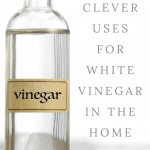
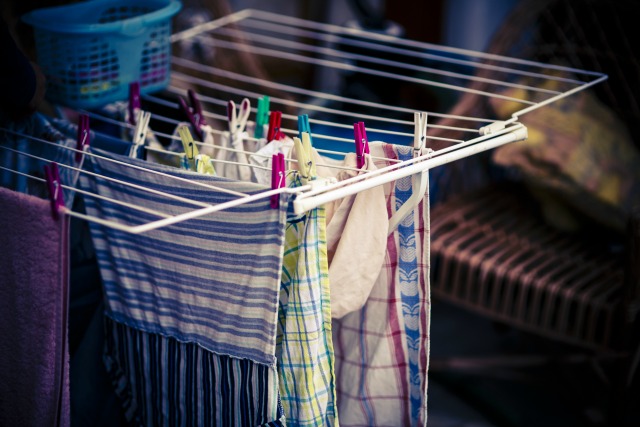
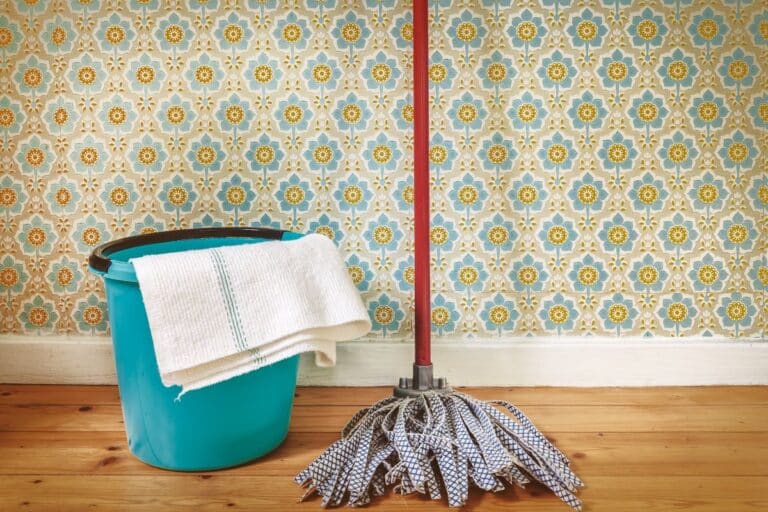
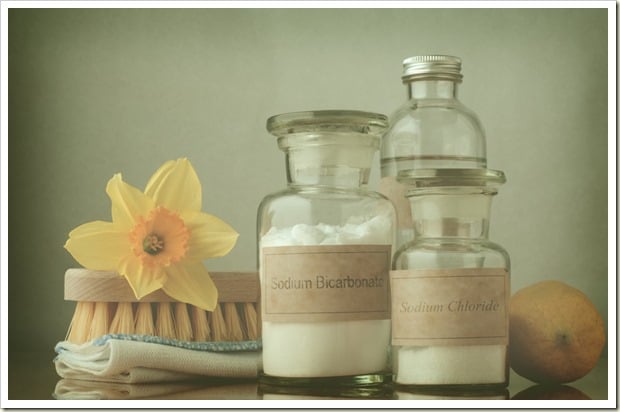
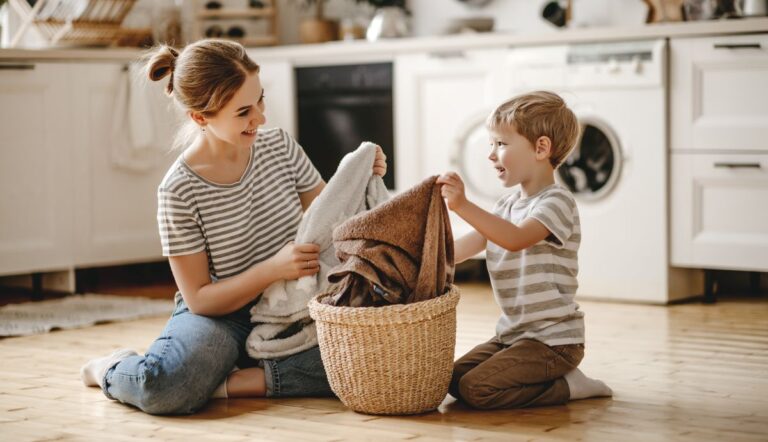
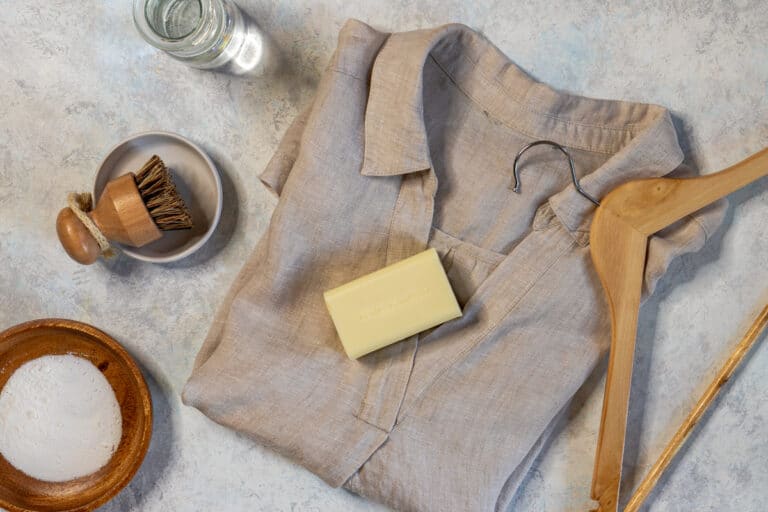
I can remember my mother-in-Law cleaning a stain on a carpet with vinegar and when it dried the stain of the vinegar stayed for ever.Sshould she have watered it down as she probably used it straight, or does it only work on wool carpets. I am asking just in case she should ever try it again…..
I have used vinegar on the carpet with great results, although I do water it down. Not sure about wool v nylon. I would recommend patch testing first.
I use it on the white vinyl floor with some bicarb, if the floor hasn’t been clean for a long while. Cuts through the muck without needing so much elbow grease. :D
Bicarb and vinegar are great for cutting through muck on the floor! We have porous tiles, so a little elbow grease is needed every now and then :).
My husband has chemical sensitvity so vinegar is used a lot in our house. When I bring home a new purchase, especially if it comes from a ‘fragrant’ shop that has a lot of imported goods (I love knick knacks) or from a garage sale, then the item in question gets a good wash and soak in detergent and vinegar. And even then sometimes it needs to sit outside for a few days. Air freshners, incense, perfume, hair sprays all stick to things and cause them to smell. It’s not the fragrance it’s the chemical behind the fragrance. Vinegar is my saviour.
That’s very interesting. Does the vinegar get rid of the smell? I’m guessing it gets rid of the chemical residue? I don’t do fragrances very well either – lots of sneezing and runny nose / eyes, itching.